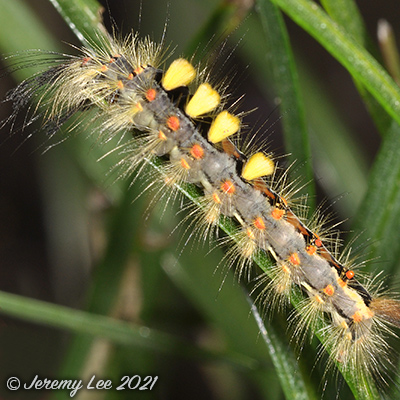
 |
|
Scientific Classifications explained » Amphibians » Ants » Aphids » Bees » Beetles » Birds » Bugs » Butterflies » Caterpillars » Damselflies » Dragonflies » Earwigs » Flies » Frog/Leafhoppers » Fungi » Galls » Grasshoppers » Harvestmen » Hoverflies » Lacewings » Ladybirds » Leaf Mines » Lichens » Mammals » Millipedes » Mosses » Moths » Sawflies » Slugs » Snails » Spiders » Trees & Shrubs » Wasps » Wild Flowers » Woodlice » Postboxes |
UK Nature > Caterpillars > Orgyia antiqua

Scientific Name: Orgyia antiqua Common Name: Vapourer Moth The male of this species has broad orange-brown wings with a pair of white eye spots. The antennae are strongly feathered. The nearly wingless female has a plump grey-brown body. Males fly in the sunshine, usually quite high, and are rarely seen at rest. An orange-brown moth flying by day in the late summer or autumn is likely to be this species. Occasionally the males also fly at night and are attracted to light traps. The females are highly sedentary and after mating lay a large batch of eggs on the cocoon from which they emerged. The caterpillar is very striking with a red and grey body and several large hair tufts. The larval stage occurs from May to September. Full-grown larvae can often be found on bushes in late summer. The caterpillar feeds on a wide range of broadleaved trees and shrubs. Habitat: woodland, heathland, moorland, hedgerows, parks and gardens. Widespread and common across much of the United Kingdom, although scarce in some western areas. |
|

https://www.uknature.co.uk is a website dedicated to showing the immense diversity of UK nature and wildlife. Our vast range of habitats, from lowland arable to snow covered mountains, from storm-ravaged coastlines to peaceful inland freshwater lakes and rivers, from dry, sandy heaths to deciduous and coniferous forests, all these habitats contribute to the abundance of UK nature. We have wild birds in huge numbers either residing or visiting our shores (597 recorded species as at July 2013) and we must also not forget the humble back garden with its grass lawns, flower beds filled with nectar rich flowers, shrubs and trees, all designed to attract huge numbers of insects such as bees, moths, butterflies and hoverflies; and finally the small ponds which provide safe havens for frogs, toads, newts and even slow worms and grass snakes. www.uknature.co.uk is the showcase for my personal passion, photographing uknature in all its glory. I sincerely hope you all enjoy the fruits of my labours. This site and all images contained therein is © Jeremy Lee 2004 - 2025. All Rights Reserved. Site design by Jeremy Lee. Site development & IT Support by Stuart Lee. |